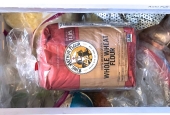
 2
2




 1
1









 1
1












 1
1




Steve Harvey wrote: it's the work smarter not harder voice inside me, wanting to learn the best way to fill this raised bed. As well as, future raised beds.
 4
4




Castaway Compost - Yer Trash be Treasure! castawaycompost.com
 2
2




 3
3








 1
1




Steve Harvey wrote:Is it possible to grow vegetables in a garden box that contains little composted soil to begin with, but mostly, peat, mulch, straw, wood, leaves, plant matter, just sort of all mixed together in a raised bed. Or does it all have to decompose first before you can plant vegetables? This would be a good option for me if I could just bring bags of lighter weight material in with reusable bags and fill the boxes over time. I am sourcing some smaller bales of straw right now, which may be able to fit through my doors and into the back yard. There was also someone advertising composted rabbit manure, I'm assuming from a rabbit farm. they are selling 50lb bags, would this be a good option for me, I know rabbit manure does not have to be composted and can be used in garden right away since it is a dry manure, correct?









Steve Harvey wrote:I really like this idea, and have been researching it alot. The only thing that concerns me is the amount of fertilizer required to prep the bales, not that it is a bad thing. Afterwards you will have very nice compost when the bales decompose, after growing in them. I would like to use organic fertilizer but every store is sold out due to the covid situation. The only organic fertilizer I could find was a small bag for $15. At 3.5 cups per bale for approx 7 days, I would have to spend about $100 on fertilizer or more, if i wanted to do 10 or more bales. What type of fertilizer would you recommend for bale gardening, that is cheap, and I can get a large bag to last the 14 days of prep for at least 10 bales?
 4
4




Castaway Compost - Yer Trash be Treasure! castawaycompost.com
 2
2




 2
2







 3
3








make sure the animals weren't fed herbicided feed
Argue for your limitations and they are yours forever.




Keith Odell wrote:Steve,
I'm a worm composter and I'm good at it, so my opinions are skewed that way. I'm also cheap. Therefore the following is a "cheap expert opinion" but maybe not helpful on this topic!
I'd fill it up with leaves, grass, wood chips, shredded paper and cardboard with some food scraps and some red worms. When it settles a bit, cover with mulch.
Add compost to where you are going to plant (google zai holes). Keep adding organic material as the original stuff will breakdown over time.
I've found that purchased, cheap, bad compost beats most purchased topsoil in final results. I will not buy topsoil again.
 1
1




 2
2











Steve Harvey wrote:
. I plan to put a raised garden box inside, that is 8' x 43" x 21"h. I also want to make the raised bed a cold frame inside the greenhouse as well.













Burl Smith wrote:
Steve Harvey wrote:
. I plan to put a raised garden box inside, that is 8' x 43" x 21"h. I also want to make the raised bed a cold frame inside the greenhouse as well.
Wont the cold frame require additional heat input to maintain growing temps if it is elevated off the floor (air space underneath? or do you plan to heat the greenhouse?




leila hamaya wrote: i think i would cut out really deep pockets in the bales for putting more dirt in there, and use manure and/or some blood meal in the soil mix.
or would rather, arrange the bales in a rectangle and then grow in the middle, all on top of very thick cardboard layer with like 5-6 pieces of cardboard thick.
another neat thing you can use whole bales and straw for is to store the harvest in the ground. i have used this method quite a few times, although i havent had enough bales to do as completely as can be...but the basic gist is to lay out the bales surrounding your in ground crops, then fill it up with loose straw, completely covering all of the plants encircled by the bales. in this way you can keep carrots, root crops, cole crops and many types of food, right in the garden until you are ready to harvest mid winter to late winter.


|
I think they should change the spelling to Sandy Eggo. This tiny ad agrees with me.
The new gardening playing cards kickstarter is now live!
https://www.kickstarter.com/projects/paulwheaton/garden-cards
|





